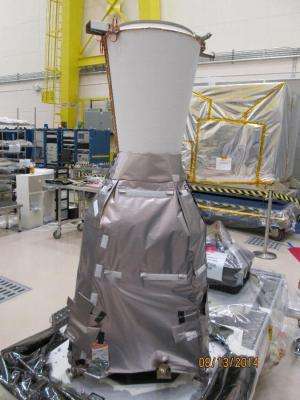First-of-its-kind Geostationary Lightning Mapper completed for GOES-R satellite

The Geostationary Lightning Mapper (GLM) instrument for NOAA's Geostationary Operational Environmental Satellite – R (GOES-R) completed development and testing and is now ready for integration with the spacecraft. The GOES-R satellite will be the first flight of this sophisticated lightning mapping instrument in geostationary orbit and will enable early predictions of intensifying storms and severe weather events.
GLM has the potential to improve severe storm warning while reducing false alarms, provide early warning of lightning ground strike hazards, and better detection and short range forecasts of heavy rainfall and flash flooding, including weather events that could affect aviation safety.
"Continuous monitoring of total lightning from space provided by the new GOES-R lightning mapper will be invaluable to our efforts at the NOAA Storm Prediction Center to warn the public and society in advance of dangerous thunderstorms and tornadoes," said Russ Schneider, director of NOAA's Storm Prediction Center in Norman, Okla.
GLM is also expected to also improve the ability to monitor the intensification of storms during radar outages, or where radar coverage is poor or scarce, such as in mountainous areas and oceanic regions. The instrument provides total lightning activity detection with both cloud-to-ground and cloud-to-cloud coverage. Unlike other ground-based sensors that primarily detect cloud-to-ground lightning, GLM will provide near-uniform coverage over oceans to better identify growing, potentially destructive thunderstorms. Data from the instrument will be used to produce a long-term database to track decadal changes in lightning activity, which is important to monitor given lightning's role in the global electric current.
"Completing the GLM instrument is an important milestone for us," said Greg Mandt, GOES-R System Program Director at NASA's Goddard Space Flight Center in Greenbelt, Maryland. "Not only will it be the first instrument of its kind to fly in geostationary orbit over the North America, but it is the final GOES-R instrument to be completed, moving all six instruments into the integration phase. This maintains the excellent progress our program is making as we move forward to launch in early 2016."
The advanced spacecraft and instrument technology on the GOES-R series satellites will result in more timely and accurate weather forecasts. It will improve support for the detection and observations of meteorological phenomena and directly affect public safety, protection of property, and ultimately, economic health and development.
The GOES-R series will be more advanced than the current GOES fleet. The satellites are expected to more than double the clarity of today's GOES imagery and provide more atmospheric observations than current capabilities with more frequent images.
More information: www.goes-r.gov/
Provided by NASA's Goddard Space Flight Center




















